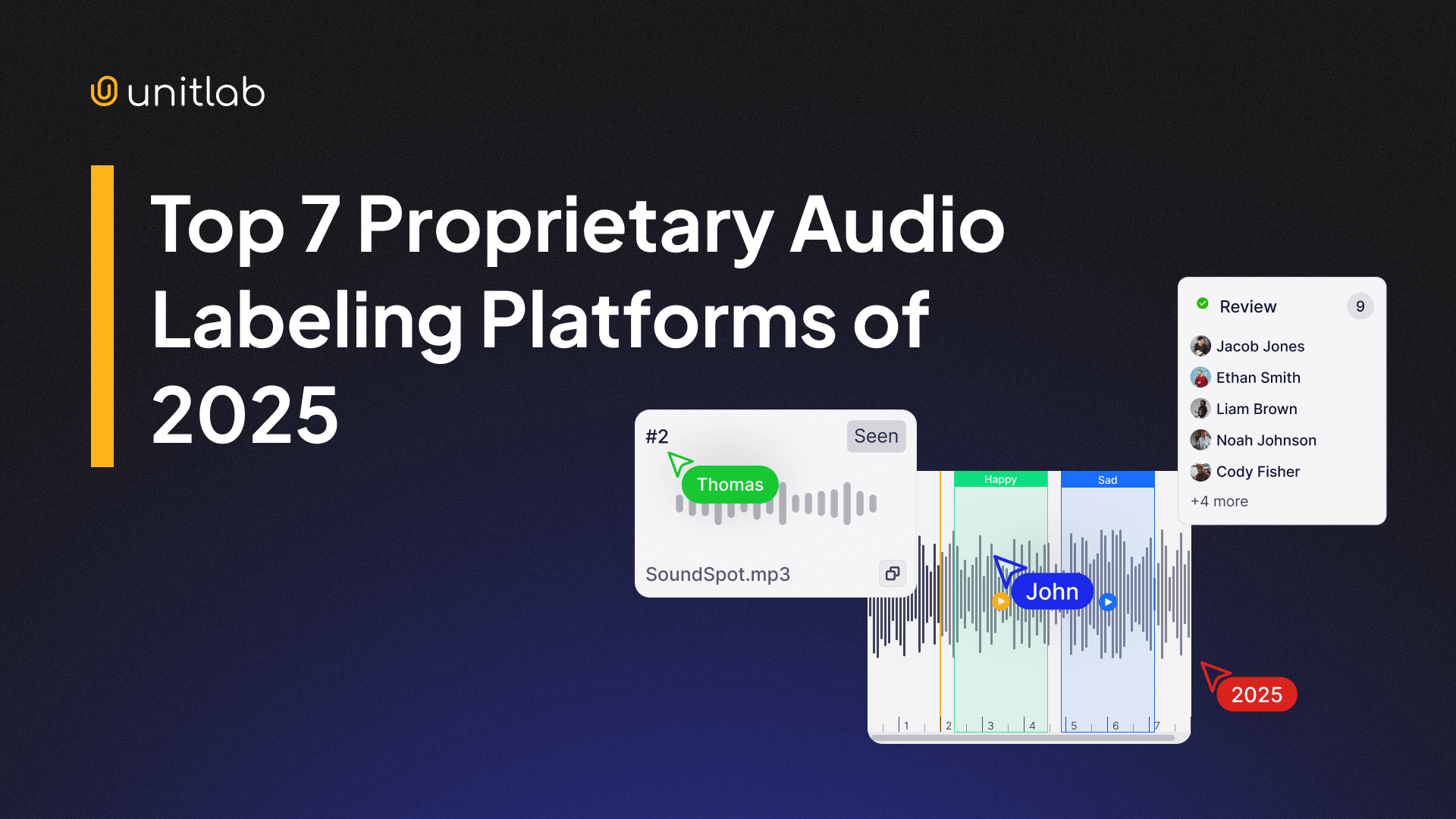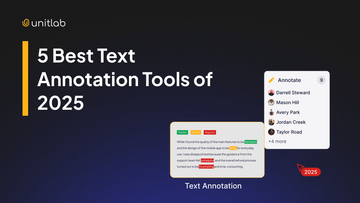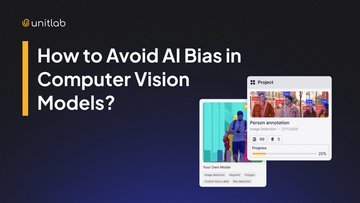Sound data, audio and video, is everywhere. Intelligent systems such as voice assistants, search engines, and robots all rely on audio data to process and respond to user requests. From call center analytics and speech recognition to emotion detection and virtual assistants, every application depends on labeled audio data for training and testing.
Audio labeling, the process of tagging sound data with relevant labels, transcriptions, and metadata, is the backbone of high-quality datasets. It transforms raw sound data, which machines cannot interpret, into structured information that AI can recognize, understand, and respond to.
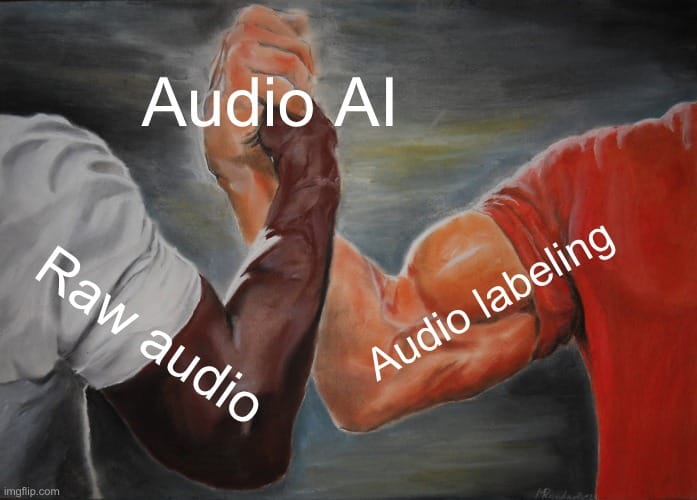
Audio annotation is a complex and multi-faceted task. That’s why we have a wide range of audio labeling tools, from simple open-source software to enterprise-scale systems. With so many options (both open-source and proprietary) it’s easy to get lost, as each platform targets different markets, use cases, and user types.
In this post, we’ll review the seven best proprietary audio annotation tools of 2025, comparing their key features, automation capabilities, and use cases.
Let's explore!
What Makes a Good Audio Annotation Tool?
It is neither possible nor fair to say audio annotation software X is better than software Y based solely on its labeling features alone. You should also consider pricing, support, and other related features, such as automation level and ease of use. It is faulty to compare apples to oranges.
Therefore, we should combine a few key factors before making an informed decision on audio labeling software. A good audio annotation tool should combine speed, accuracy, and scalability to create high-quality audio sets for Audio AI.
That said, here's our assessment across these categories that should make an audio labeling tool a good one:
- Annotation types: Supported audio annotation types (audio segmentation, transcription, emotion detection, etc).
- Dataset management: Import/export, version control, and storage.
- Automation: APIs, SDKs, CLI tools, and integration with other frameworks.
- Collaboration: Real-time project tracking, reviewer assignment, and QA control.
- Scalability: Ability to handle thousands of hours of audio efficiently.
- Pricing: Free tiers, licenses, custom plans.
- Target Audience: Who the tool is for (startups, enterprises).
Tools Overview
Here are the 7 paid audio labeling tools we'll review according to the criteria above:
- Unitlab AI
- Encord
- SuperAnnotate
- Prodigy
- Appen
- iMerit
- Labellerr
For a quick comparison between these audio labeling vendors, here's the summary table:
| Tool | Dataset Management | Pricing | Audience |
|---|---|---|---|
| Unitlab AI | Strong, built-in | SaaS + free tiers | Medium teams, startups |
| Encord | Enterprise-grade suite | Vendor / enterprise pricing | Large enterprises |
| SuperAnnotate | Full lifecycle | Quote-based / enterprise tier | Large enterprises |
| Prodigy | Minimal, spaCy | One-time purchase | Individual developers |
| Appen | Managed datasets | Custom / enterprise pricing | Companies that outsource |
| iMerit | Managed datasets | Custom pricing | Domain-specific companies |
| Labellerr | Strong, built-in | SaaS + free tiers | Startups, research groups |
1. Unitlab AI
Unitlab Annotate is a fully automated data annotation platform focused on human-in-the-loop workflows and efficient QA mechanisms. It supports image, text, and audio labeling, offering pre-trained models for auto-annotation and BYO (Bring Your Own) model integration to build agentic AI workflows.
For audio labeling, this tool offers a customizable audio dashboard and hotkeys, as well as effortless collaboration and quality assurance among human labelers and reviewers.
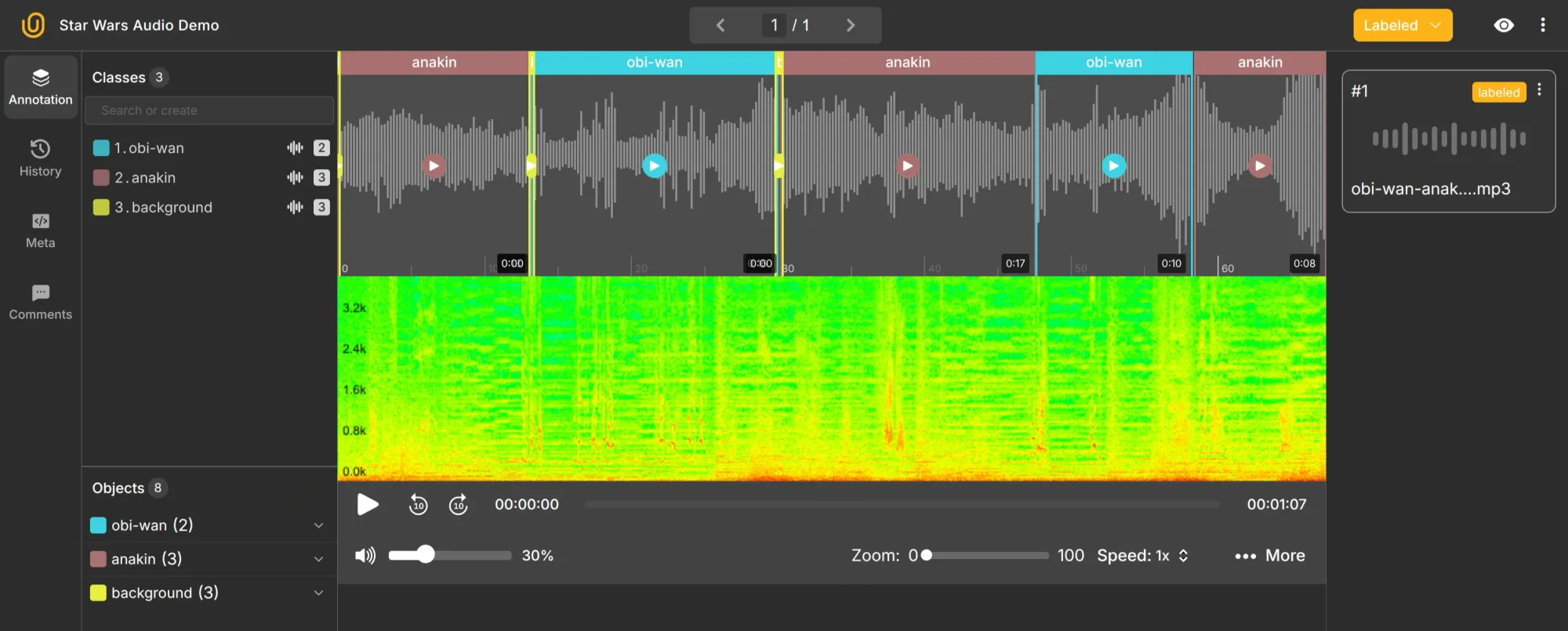
Overview
- Annotation types: audio segmentation, classification, translation, emotion detection, and more
- Dataset management: built-in cloud dataset management with version control; supports RTTM and Audio JSON; training, validation, and testing splits
- Automation: API, SDK, and CLI tools for integration and automation
- Collaboration: robust QA between labelers and reviewers; project management and performance tracking
- Scalability: agentic AI workflows with BYO model support, scaling from hundreds to millions of samples
- Pricing: free tier for small projects; transparent SaaS plans for production use
- Target Audience: medium to large teams scaling their audio annotation pipelines
2. Encord
Encord is a multimodal data platform that handles data curation, annotation, and management for large audio labeling projects. It supports multiple unstructured data types: audio, video, text, images, documents, and others.
This means, it is possible to conduct multimodal data labeling within this software: labeling text and images along with audio files in one place.
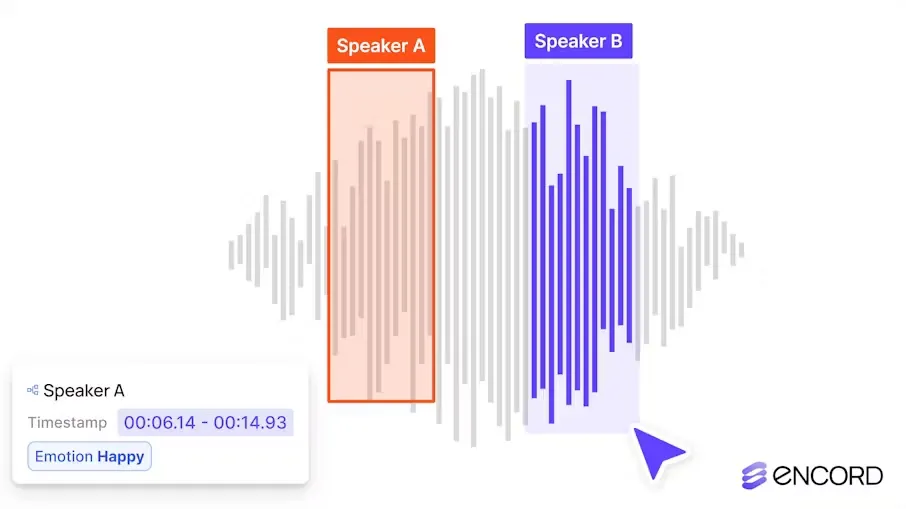
Overview
- Annotation types: speech recognition, emotion detection, sound event detection, audio classification, and others
- Dataset management: cloud-based datasets with mirroring and version control
- Automation: Encord SDK compatible with PyTorch and TensorFlow
- Collaboration: progress tracking, change logs, and built-in review workflows
- Scalability: AI-driven pre-labeling and quality control for faster, more accurate results
- Pricing: custom quotes and enterprise pricing
- Target Audience: enterprises managing large-scale speech AI datasets
3. SuperAnnotate
SuperAnnotate is an end-to-end, fully-fledged data platform partnered with industry leaders, such as NVIDIA and Databricks. Known for its rich interface and multimodal support, this platform supports textual, image, audio, and video labeling.
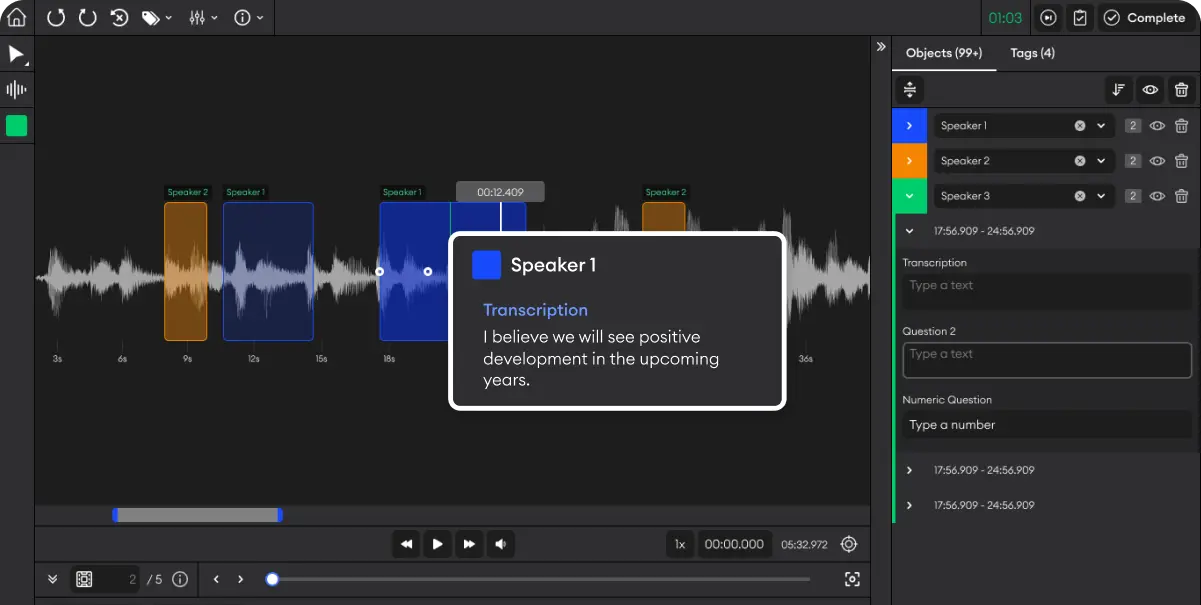
Overview
- Annotation types: speech recognition, speaker identification, sound event detection, and classification
- Dataset management: secure cloud-based dataset storage with versioning and format export/import flexibility
- Automation: APIs, SDKs, and integrations with ML frameworks like TensorFlow and PyTorch
- Collaboration: Analytics dashboards, role-based access, and QA workflows
- Scalability: pre-labeling using built-in AI models for high-volume projects
- Pricing: custom enterprise pricing
- Target Audience: large enterprises
4. Prodigy
Prodigy, created by the makers of spaCy, is a developer-friendly annotation tool for Python users. It supports audio and video labeling in addition to NLP tasks. It is built for developers and researchers who prefer Python scripting and command-line workflows.
Prodigy supports active learning by models, in which models generate labels and human annotators verify them, making the model more accurate over time.
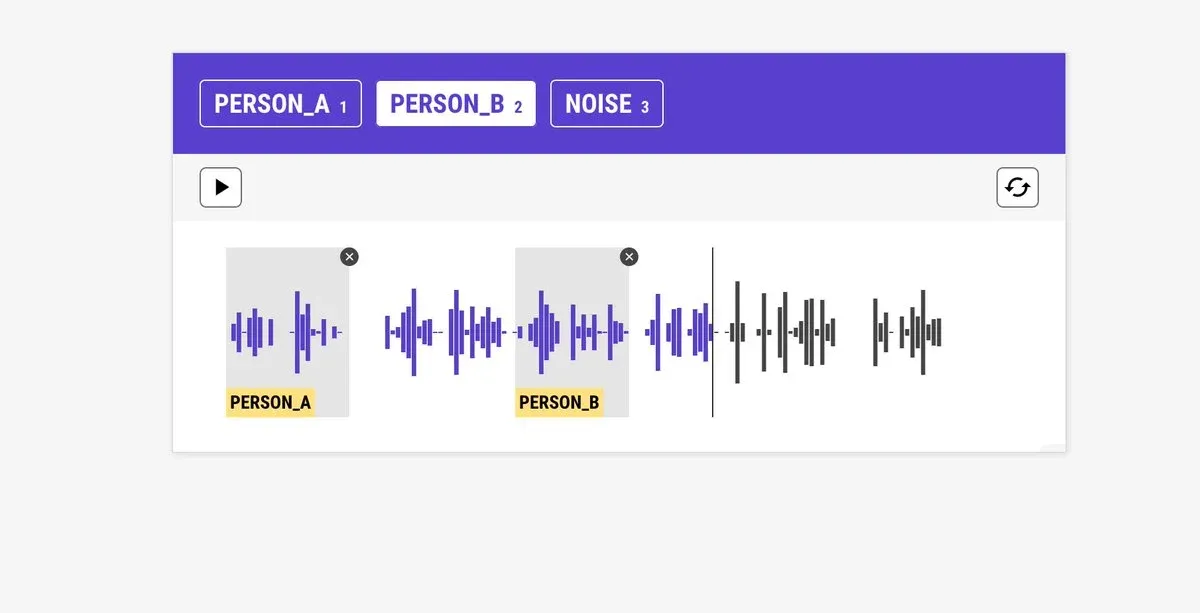
Overview
- Annotation types: transcription, classification, speaker diarization, and more
- Dataset management: local project storage with spaCy integration
- Automation: tight integration with ML frameworks via Python scripts
- Collaboration: limited; mainly for individuals or small research teams
- Scalability: modest—best for custom, small-to-medium projects
- Pricing: one-time license fee ($390 for individuals, $490 for companies)
- Target Audience: researchers and developers who want control and flexibility
5. Appen
Appen is one of the world’s largest managed data providers, covering the full AI data lifecycle: data sourcing, data preparation, model development, and model evaluation.
It provides a unified data annotation platform and brings together a large global annotator network for even domain-specific datasets.

Overview
- Annotation types: transcription, intent labeling, multilingual annotation, and more
- Dataset management: fully managed datasets with access control and versioning
- Automation: Appen Platform API for integration into enterprise workflows
- Collaboration: built-in dashboards and QA systems for teams and clients
- Scalability: extensive, with global workforce and AI Data Platform (ADAP)
- Pricing: ustom, depending on project scope
- Target Audience: enterprises outsourcing large-scale labeling tasks
6. iMerit
iMerit combines domain-specific human expertise with AI-powered automation to deliver scalable audio labeling solutions. This software supports image, video, text, audio, and LiDAR annotations. Its global workforce operates globally through the Ango Hub platform.
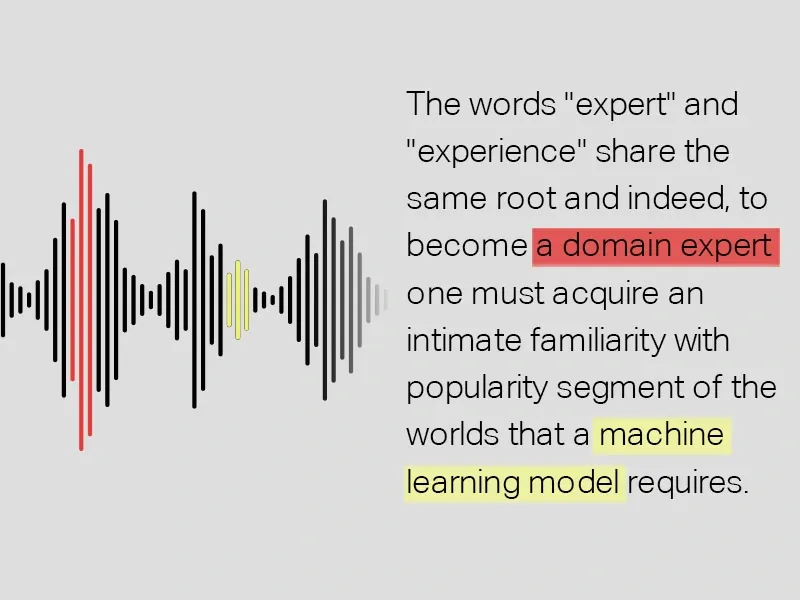
Overview
- Annotation types: audio transcription, emotion recognition, sentiment analysis, and multi-language transcription with dialect variation
- Dataset management: managed datasets with flexible configuration
- Automation: iMerit Self-Serve API for custom setup and integrations
- Collaboration: human-AI quality control and structured review workflows
- Scalability: enterprise-grade scaling for high-volume projects
- Pricing: project-based custom pricing
- Target Audience: enterprises requiring accurate, domain-specific labeling
7. Labellerr
Labellerr is an AI-driven data annotation tool designed for collaborative audio annotation. Its focus on auto-annotation with AI models and automation through its SDK make it ideal for handling large volumes of audio data, particularly in industries that require high accuracy and speed.
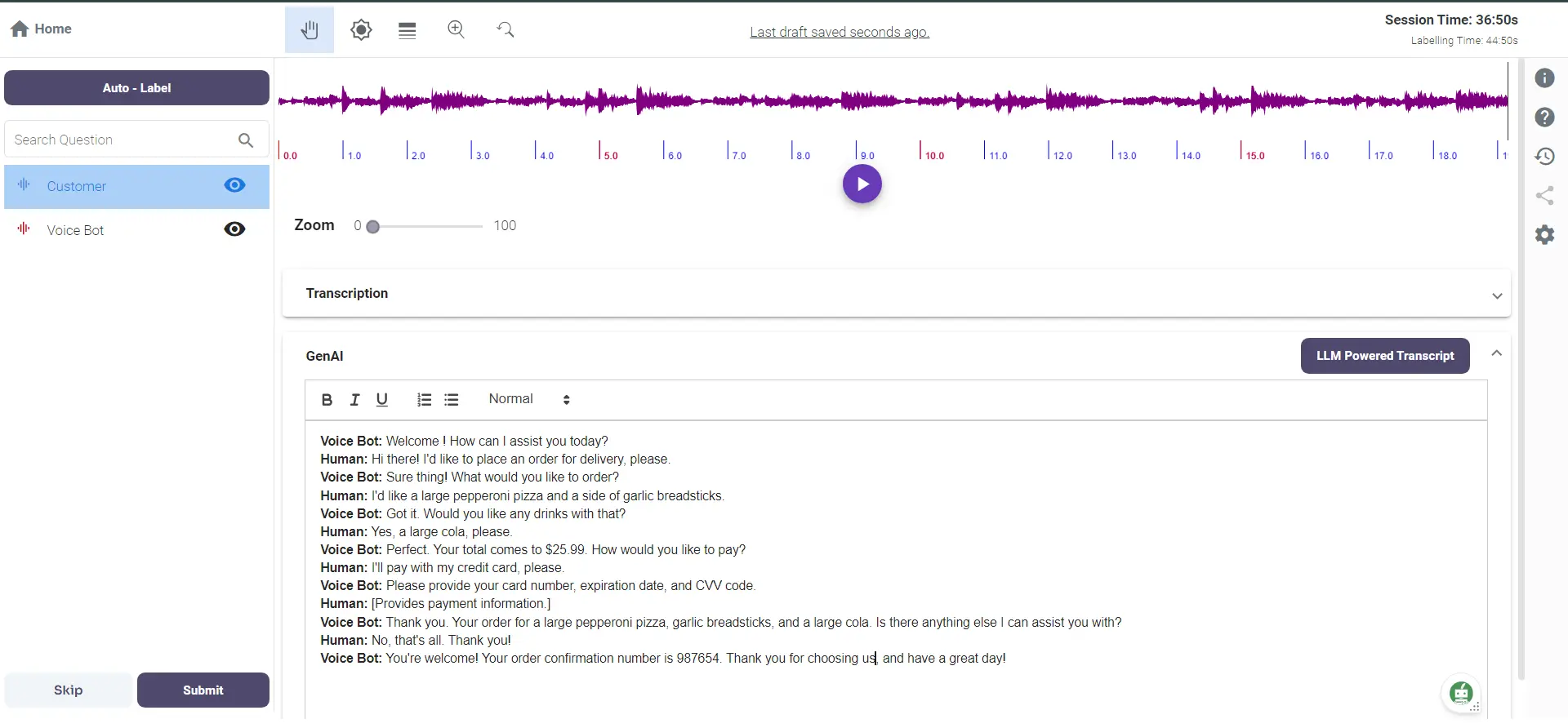
Overview
- Annotation types: speech recognition, sound classification, and sentiment analysis and more
- Dataset management: version control, managed storage, and data import/export
- Automation: Labellerr Python SDK for managing annotations, project workflows, and integrations.
- Collaboration: project tracking, task assignments, and review systems
- Scalability: AI-driven automation for faster processing and reduced manual work
- Pricing: free plan for students and researchers; paid pro and enterprise tiers
- Target Audience: small to mid-sized teams needing flexible automation
Recommendations
So, now what? Which audio annotation software should you use to build an audio set for your Audio AI? If you are planning to allocate a budget to use a proprietary audio annotation tool, your audio labeling project is most likely important for business and at scale.
We have reviewed 7 best paid audio labeling tools across the same select categories. Although we cannot pick the tool for you (that depends on your project, obviously), we can make these recommendations:
- Choose Unitlab AI for automation and reasoning-driven workflows.
- Use Encord or SuperAnnotate for enterprise-grade control.
- Pick Prodigy for full customization and local processing.
- Outsource to Appen or iMerit for large managed projects.
- Try Labellerr if you’re a startup or research team looking for balance.
Choose what works best for you (and your budget). Good luck!
Conclusion
Audio labeling is important because AI can learn massive amounts from processed audio files, not just raw sound data. But how do we go from raw, useless sound data to valuable audio sets for Audio AI efficiently and effectively?
Audio annotation platforms have emerged as the answer in recent years. But which one? The legitimate, right tool depends on your priorities: automation, control, or scalability.
We have explored 7 paid tools for you across the same benchmark. Hopefully, you can now make an informed decision.
Explore More
Check out the following resource for more on audio annotation tools:
References
- Justin Sharps (Oct 29, 2024). Top 9 Audio Annotation Tools. Encord Blog: Source
- iMerit (no date). Top 10 Tools for Audio Annotation in 2025: A Comprehensive Guide. iMerit: Source
- Sumit Singh 10 Best Audio Annotation & Labeling Service Providers In 2025. Labellerr: Source
- Vicky (May 08, 2025). Best Audio Annotation and Labelling Services for AI Models. Twine: Source

